Streamflow Simulation in the Cau River Basin, Northeast Vietnam, Using SWAT-Based Hydrological Modelling
Abstract
1. Introduction
2. Materials and Methods
2.1. Study Area
2.2. Data and Preprocessing
2.2.1. Meteorological and Hydrological Data
2.2.2. Topographic Data
2.2.3. Soil Types and Characteristics
2.2.4. LULC Data
2.3. SWAT Model Development
2.4. Sensitivity Analysis, Calibration and Validation
2.5. Model Performance Metrics
3. Results
3.1. Parameter Sensitivity Analysis
3.2. Model Performance
3.3. Spatio-Temporal Variation of Surface Runoff
3.3.1. Spatial Variation of Surface Runoff
3.3.2. Temporal Variation of Surface Runoff
4. Discussions
5. Conclusions
Author Contributions
Funding
Data Availability Statement
Acknowledgments
Conflicts of Interest
Abbreviations
| GIS | Geographic Information System |
| ArcSwat | ArcGIS interface for the Soil and Water Assessment Tool |
| DEM | Digital Elevation Model |
| FAO | Food and Agriculture Organisation |
| HWSD | Harmonised World Soil Database |
| HRU | Hydrologic Response Unit |
| LULC | Land Use and Land Cover |
| NSE | Nash–Sutcliffe Efficiency |
| PBIAS | Percent Bias |
| R2 | Coefficient of determination |
| RMSE | Root Mean Square Error |
| RSR | Root Mean Square Error to observations Standard deviation Ratio |
| SWAT | Soil and Water Assessment Tool |
| SWAT-CUP | SWAT–Calibration and Uncertainty Procedures |
| SUFI-2 | Sequential Uncertainty Fitting ver. 2 |
| SRTM | Shuttle Radar Topography Mission |
| USGS | United States Geological Survey |
References
- Davie, T. Fundamentals of Hydrology; Routledge: London, UK, 2019. [Google Scholar]
- Wang, Y.; Jiang, R.; Xie, J.; Zhao, Y.; Yan, D.; Yang, S. Soil and water assessment tool (SWAT) model: A systemic review. J. Coast. Res. 2019, 93, 22–30. [Google Scholar] [CrossRef]
- Janjić, J.; Tadić, L. Fields of application of SWAT hydrological model—A review. Earth 2023, 4, 331–344. [Google Scholar] [CrossRef]
- Yang, D.; Yang, Y.; Xia, J. Hydrological cycle and water resources in a changing world: A review. Geogr. Sustain. 2021, 2, 115–122. [Google Scholar] [CrossRef]
- Biggs, D.; Miller, F.; Hoanh, C.T.; Molle, F. The delta machine: Water management in the Vietnamese Mekong Delta in historical and contemporary perspectives. In Contested Waterscapes in the Mekong Region; Routledge: London, UK, 2012; pp. 203–225. [Google Scholar]
- Pham, Q.-N.; Nguyen, N.-H.; Ta, T.-T.; Tran, T.-L. Vietnam’s water resources: Current status, challenges, and security perspective. Sustainability 2023, 15, 6441. [Google Scholar] [CrossRef]
- Wada, Y.; Bierkens, M.F.; De Roo, A.; Dirmeyer, P.A.; Famiglietti, J.S.; Hanasaki, N.; Konar, M.; Liu, J.; Müller Schmied, H.; Oki, T. Human–water interface in hydrological modelling: Current status and future directions. Hydrol. Earth Syst. Sci. 2017, 21, 4169–4193. [Google Scholar] [CrossRef]
- Fiener, P.; Auerswald, K.; Van Oost, K. Spatio-temporal patterns in land use and management affecting surface runoff response of agricultural catchments—A review. Earth-Sci. Rev. 2011, 106, 92–104. [Google Scholar] [CrossRef]
- Singh, V. Effect of spatial and temporal variability in rainfall and watershed characteristics on stream flow hydrograph. Hydrol. Process. 1997, 11, 1649–1669. [Google Scholar] [CrossRef]
- Swain, S.; Mishra, S.; Pandey, A.; Pandey, A.; Jain, A.; Chauhan, S.; Badoni, A.K. Hydrological modelling through SWAT over a Himalayan catchment using high-resolution geospatial inputs. Environ. Chall. 2022, 8, 100579. [Google Scholar] [CrossRef]
- Iqbal, S.; Haider, R.; Pasha, G.A.; Zhao, L.; Abbas, F.M.; Anjum, N.; Murtaza, N.; Abbas, Z. Numerical Investigation of Flow Around Partially and Fully Vegetated Submerged Spur Dike. Water 2025, 17, 435. [Google Scholar] [CrossRef]
- Himanshu, S.K.; Pandey, A.; Yadav, B.; Gupta, A. Evaluation of best management practices for sediment and nutrient loss control using SWAT model. Soil Tillage Res. 2019, 192, 42–58. [Google Scholar] [CrossRef]
- Chakraborty, K.; Saha, S.; Mandal, D. Hydrological modelling using SWAT for the assessment of streamflow dynamics in the Ganga River basin. Environ. Sci. Pollut. Res. 2024, 32, 10258–10278. [Google Scholar] [CrossRef]
- Sharma, U.; Sharma, V.; Eslamian, S. Flood Management; Larsen and Keller Education: New York, NY, USA, 2022; p. 79. [Google Scholar]
- Bui, H.H.; Ha, N.H.; Nguyen, T.N.D.; Nguyen, A.T.; Pham, T.T.H.; Kandasamy, J.; Nguyen, T.V. Integration of SWAT and QUAL2K for water quality modeling in a data scarce basin of Cau River basin in Vietnam. Ecohydrol. Hydrobiol. 2019, 19, 210–223. [Google Scholar] [CrossRef]
- Dao, D.M.; Lu, J.; Chen, X.; Kantoush, S.A.; Binh, D.V.; Phan, P.; Tung, N.X. Predicting tropical monsoon hydrology using CFSR and CMADS data over the Cau River Basin in Vietnam. Water 2021, 13, 1314. [Google Scholar] [CrossRef]
- Thai, T.H.; Thao, N.P.; Dieu, B.T. Assessment and simulation of impacts of climate change on erosion and water flow by using the soil and water assessment tool and GIS: Case Study in Upper Cau River basin in Vietnam. Earth Sci. 2017, 39, 376–392. [Google Scholar] [CrossRef]
- Tran, V.-B.; Ishidaira, H.; Nakamura, T.; Do, T.-N.; Nishida, K. Estimation of nitrogen load with multi-pollution sources using the SWAT model: A case study in the Cau River Basin in Northern Vietnam. J. Water Environ. Technol. 2017, 15, 106–119. [Google Scholar] [CrossRef]
- Son, C.T.; Giang, N.T.H.; Thao, T.P.; Nui, N.H.; Lam, N.T.; Cong, V.H. Assessment of Cau River water quality assessment using a combination of water quality and pollution indices. J. Water Supply Res. Technol.—AQUA 2020, 69, 160–172. [Google Scholar] [CrossRef]
- Hien, H.N.; Hoang, B.H.; Huong, T.T.; Than, T.T.; Ha, P.T.T.; Toan, T.D.; Son, N.M. Study of the climate change impacts on water quality in the upstream portion of the cau river basin, vietnam. Environ. Model. Assess. 2016, 21, 261–277. [Google Scholar] [CrossRef]
- Le, T.T.T.; Kawagoe, S. Evaluation of landslide susceptibility in Cau River Basin using a physical-based model under impact of climate change. Open J. Mod. Hydrol. 2018, 9, 1. [Google Scholar]
- Mohseni, U.; Agnihotri, P.G.; Pande, C.B.; Durin, B. Understanding the climate change and land use impact on streamflow in the present and future under CMIP6 climate scenarios for the Parvara Mula Basin, India. Water 2023, 15, 1753. [Google Scholar] [CrossRef]
- Devia, G.K.; Ganasri, B.P.; Dwarakish, G.S. A review on hydrological models. Aquat. Procedia 2015, 4, 1001–1007. [Google Scholar] [CrossRef]
- Bo, H.; Dong, X.; Li, Z.; Reta, G.; Li, L.; Wei, C. Comparison of Two Versions of SWAT Models in Predicting the Streamflow in the Xuanmiaoguan Reservoir Catchment. Nat. Environ. Pollut. Technol. 2022, 21, 529–541. [Google Scholar] [CrossRef]
- Arnold, J.G.; Srinivasan, R.; Muttiah, R.S.; Williams, J.R. Large area hydrologic modeling and assessment part I: Model development 1. JAWRA J. Am. Water Resour. Assoc. 1998, 34, 73–89. [Google Scholar] [CrossRef]
- Liu, H.; Wang, T.; Feng, Y.; Liu, F.; Wang, N.; Wang, H.; Liu, W.; Sun, F. Identifying Reservoir-Induced Hydrological Alterations in the Upper Yangtze River Basin through Statistical and Modeling Approaches. Water 2023, 15, 2914. [Google Scholar] [CrossRef]
- Mwitalemi, S.S.; Kantoush, S.A.; Nguyen, B.Q. Effects of Cascading Dams on Streamflow within the Downstream Areas of the Rufiji River Basin in Tanzania. Hydrology 2024, 11, 69. [Google Scholar] [CrossRef]
- Wang, G.; Mang, S.; Cai, H.; Liu, S.; Zhang, Z.; Wang, L.; Innes, J.L. Integrated watershed management: Evolution, development and emerging trends. J. For. Res. 2016, 27, 967–994. [Google Scholar] [CrossRef]
- Doost, Z.H.; Alsuwaiyan, M.; Yaseen, Z.M. Runoff management based water harvesting for better water resources sustainability: A comprehensive review. Knowl.-Based Eng. Sci. 2024, 5, 1–45. [Google Scholar] [CrossRef]
- Jiang, D.; Wang, K. The role of satellite-based remote sensing in improving simulated streamflow: A review. Water 2019, 11, 1615. [Google Scholar] [CrossRef]
- Bach, T.V. Application of the SWAT Model for Simulating Streamflow and Sediment Yield. J. Water Resour. Environ. Eng. 2017, 57, 136–142. [Google Scholar]
- MONRE. Vietnam National Environmental Report 2006: Status of Three Water Basin: Cau River, Nhue–Day River and Dong Nai River; Ministry of Natural Resources and Environment: Hanoi, Vietnam, 2006. [Google Scholar]
- Quy, L.D. Developing flood inundation maps of Bac Thai caused by flooding from the Cau River and Cong River. J. Meteorol. Hydrol. 1990, 353, 15–23. [Google Scholar]
- Duong Thi, L.; Do Van, T.; Le Van, H. Detection of flash-flood potential areas using watershed characteristics: Application to Cau River watershed in Vietnam. J. Earth Syst. Sci. 2020, 129, 120. [Google Scholar] [CrossRef]
- Arnold, J.G.; Moriasi, D.N.; Gassman, P.W.; Abbaspour, K.C.; White, M.J.; Srinivasan, R.; Santhi, C.; Harmel, R.; Van Griensven, A.; Van Liew, M.W. SWAT: Model use, calibration, and validation. Trans. ASABE 2012, 55, 1491–1508. [Google Scholar] [CrossRef]
- Abbaspour, K.C. SWAT-CUP: SWAT calibration and uncertainty programs—A user manual. Eawag 2015, 100, 16–70. [Google Scholar]
- Zandbergen, P. Applications of shuttle radar topography mission elevation data. Geogr. Compass 2008, 2, 1404–1431. [Google Scholar] [CrossRef]
- Rabus, B.; Eineder, M.; Roth, A.; Bamler, R. The shuttle radar topography mission—A new class of digital elevation models acquired by spaceborne radar. ISPRS J. Photogramm. Remote Sens. 2003, 57, 241–262. [Google Scholar] [CrossRef]
- Moradkhani, H.; Sorooshian, S. General review of rainfall-runoff modeling: Model calibration, data assimilation, and uncertainty analysis. In Hydrological Modelling the Water Cycle: Coupling the Atmospheric Hydrological Models; Springer: Berlin/Heidelberg, Germany, 2009; pp. 1–24. [Google Scholar]
- Neitsch, S.L.; Arnold, J.G.; Kiniry, J.R.; Williams, J.R.; King, K. Soil and Water Assessment Tool: Theoretical Documentation: Version 2005; Grassland Soil and Water Research Laboratory: Temple, TX, USA, 2005. [Google Scholar]
- FAO; IIASA. Harmonized World Soil Database Version 2.0; FAO: Rome, Italy; IIASA: Laxenburg, Austria, 2023. [Google Scholar] [CrossRef]
- Poggio, L.; De Sousa, L.M.; Batjes, N.H.; Heuvelink, G.B.; Kempen, B.; Ribeiro, E.; Rossiter, D. SoilGrids 2.0: Producing soil information for the globe with quantified spatial uncertainty. Soil 2021, 7, 217–240. [Google Scholar] [CrossRef]
- Kaliappan, S.; Venkatraman, V. Determination of parameters for watershed delineation using various satellite derived digital elevation models and its accuracy. Glob. Nest J. 2023, 25, 124–137. [Google Scholar]
- Kim, K.B.; Kwon, H.-H.; Han, D. Exploration of warm-up period in conceptual hydrological modelling. J. Hydrol. 2018, 556, 194–210. [Google Scholar] [CrossRef]
- Wu, H.; Chen, B. Evaluating uncertainty estimates in distributed hydrological modeling for the Wenjing River watershed in China by GLUE, SUFI-2, and ParaSol methods. Ecol. Eng. 2015, 76, 110–121. [Google Scholar] [CrossRef]
- Zhao, F.; Wu, Y.; Qiu, L.; Sun, Y.; Sun, L.; Li, Q.; Niu, J.; Wang, G. Parameter uncertainty analysis of the SWAT model in a mountain-loess transitional watershed on the Chinese Loess Plateau. Water 2018, 10, 690. [Google Scholar] [CrossRef]
- Nossent, J. Sensitivity and Uncertainty Analysis in View of the Parameter Estimation of a SWAT Model of the River Kleine Nete, Belgium. Ph.D. Thesis, Vrije Universiteit Brussel, Brussels, Belgium, 2012. [Google Scholar]
- Arnold, J.; Kiniry, J.; Srinivasan, R.; Williams, J.; Haney, E.; Neitsch, S. Soil and Water Assessment Tool Input/Output File Documentation Version 2009; Texas Water Resources Institute: College Station, TX, USA, 2011. [Google Scholar]
- Moriasi, D.N.; Arnold, J.G.; Van Liew, M.W.; Bingner, R.L.; Harmel, R.D.; Veith, T.L. Model evaluation guidelines for systematic quantification of accuracy in watershed simulations. Trans. ASABE 2007, 50, 885–900. [Google Scholar] [CrossRef]
- Gupta, H.V.; Kling, H.; Yilmaz, K.K.; Martinez, G.F. Decomposition of the mean squared error and NSE performance criteria: Implications for improving hydrological modelling. J. Hydrol. 2009, 377, 80–91. [Google Scholar] [CrossRef]
- Nash, J.E.; Sutcliffe, J.V. River flow forecasting through conceptual models part I—A discussion of principles. J. Hydrol. 1970, 10, 282–290. [Google Scholar] [CrossRef]
- Yates, F. The analysis of multiple classifications with unequal numbers in the different classes. J. Am. Stat. Assoc. 1934, 29, 51–66. [Google Scholar] [CrossRef]
- Moriasi, D.N.; Gitau, M.W.; Pai, N.; Daggupati, P. Hydrologic and Water Quality Models: Performance Measures and Evaluation Criteria. Trans. ASABE 2015, 58, 1763–1785. [Google Scholar] [CrossRef]
- Singh, S.K.; Kanga, S.; Gulati, B.; Raič, M.; Sajan, B.; Đurin, B.; Singh, S. Spatial and temporal analysis of hydrological modelling in the Beas basin using SWAT+ model. Water 2023, 15, 3338. [Google Scholar] [CrossRef]
- Mengistu, D.; Sorteberg, A. Sensitivity of SWAT simulated streamflow to climatic changes within the Eastern Nile River basin. Hydrol. Earth Syst. Sci. 2012, 16, 391–407. [Google Scholar] [CrossRef]
- Leta, M.K.; Ebsa, D.G.; Regasa, M.S.; Shokrollahi, A. Parameter Uncertainty Analysis for Streamflow Simulation Using SWAT Model in Nashe Watershed, Blue Nile River Basin, Ethiopia. Appl. Environ. Soil Sci. 2022, 2022, 1826942. [Google Scholar] [CrossRef]
- Ashu, A.B.; Lee, S.-I. Multi-site calibration of hydrological model and spatio-temporal assessment of water balance in a monsoon watershed. Water 2023, 15, 360. [Google Scholar] [CrossRef]
- Department of Natural Resources and Environment of Thai Nguyen. Assessment of Land Use Change in Thai Nguyen During 2011–2020; Department of Natural Resources and Environment of Thai Nguyen: Thai Nguyen, Vietnam, 2021. [Google Scholar]
- Department of Natural Resources and Environment of Bac Kan. Assessment of Land Use Change in Bac Kan During 2011–2020; Department of Natural Resources and Environment of Bac Kan: Bac Kan, Vietnam, 2021. [Google Scholar]
- Blanco-Gómez, P.; Jimeno-Sáez, P.; Senent-Aparicio, J.; Pérez-Sánchez, J. Impact of climate change on water balance components and droughts in the Guajoyo River Basin (El Salvador). Water 2019, 11, 2360. [Google Scholar] [CrossRef]
- Kumar, A.; Singh, R.P.; Dubey, S.K.; Gaurav, K. Streamflow of the Betwa river under the combined effect of LU-LC and climate change. Agriculture 2022, 12, 2005. [Google Scholar] [CrossRef]
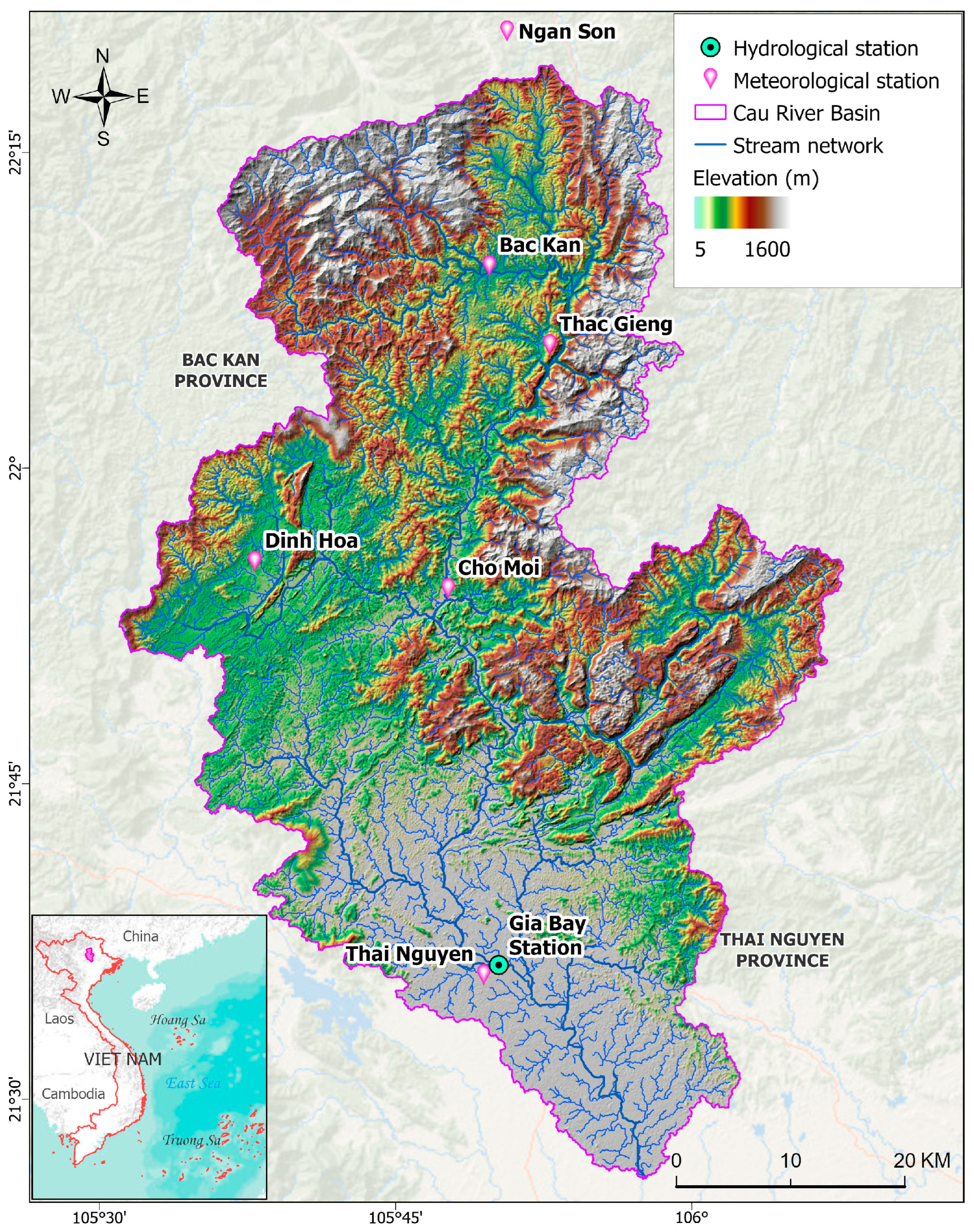
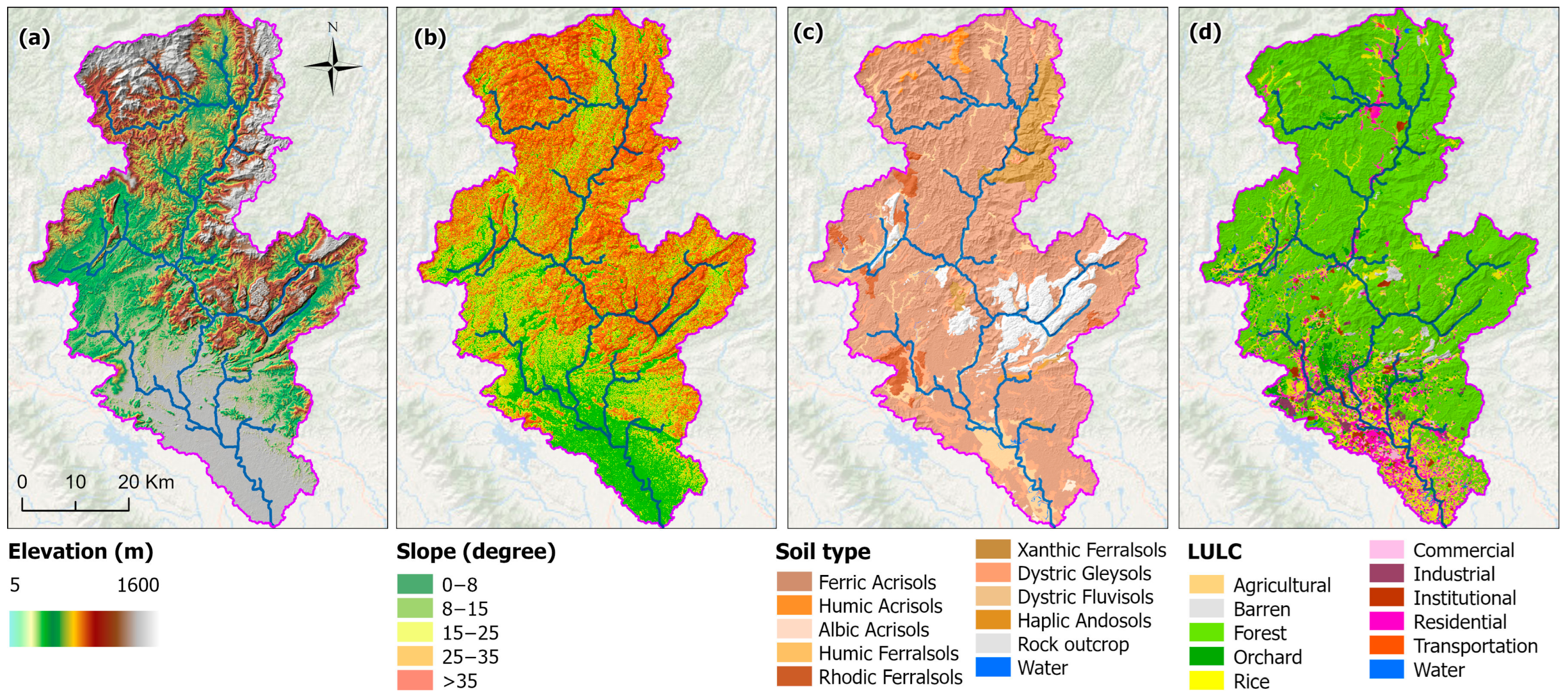
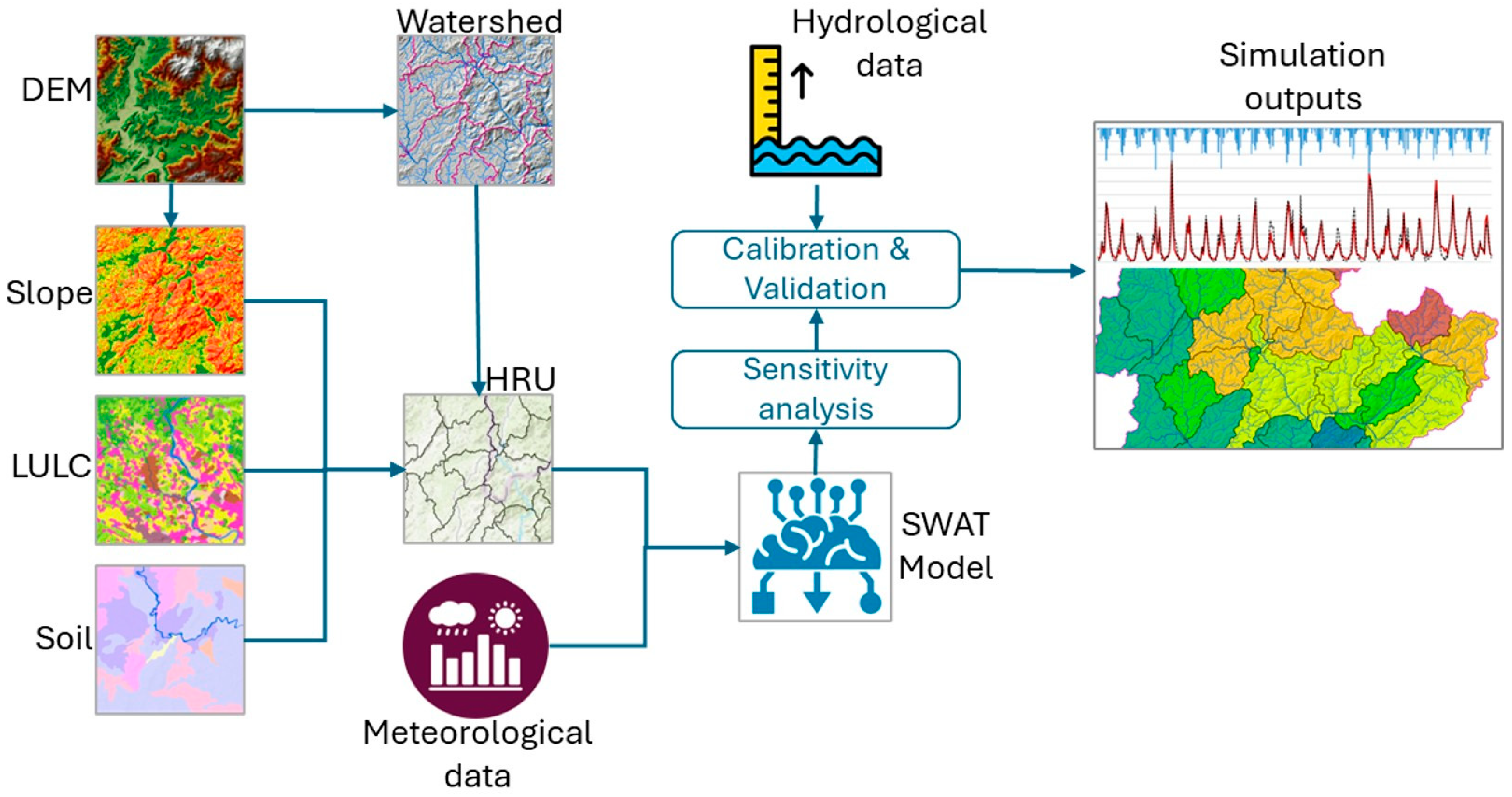
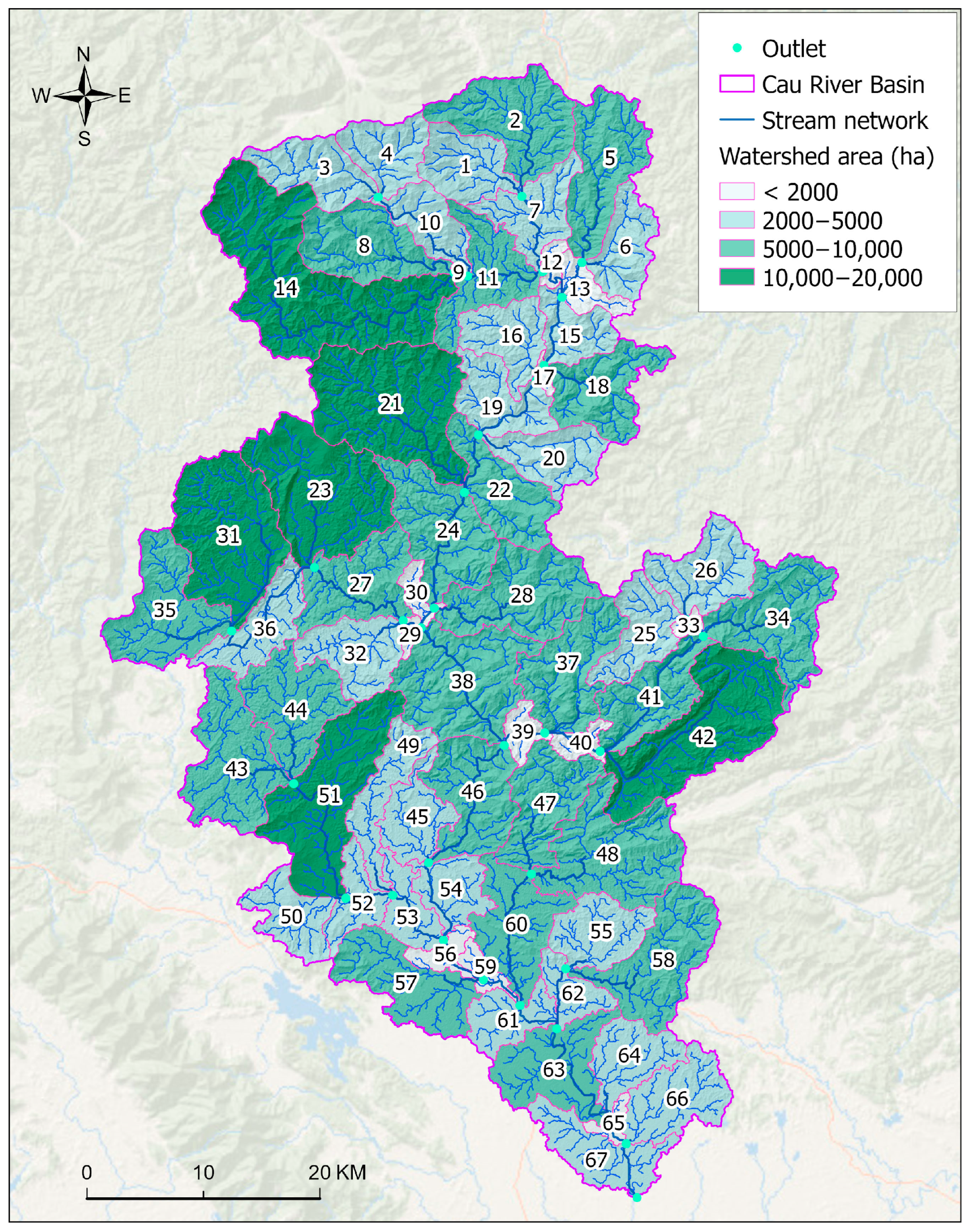
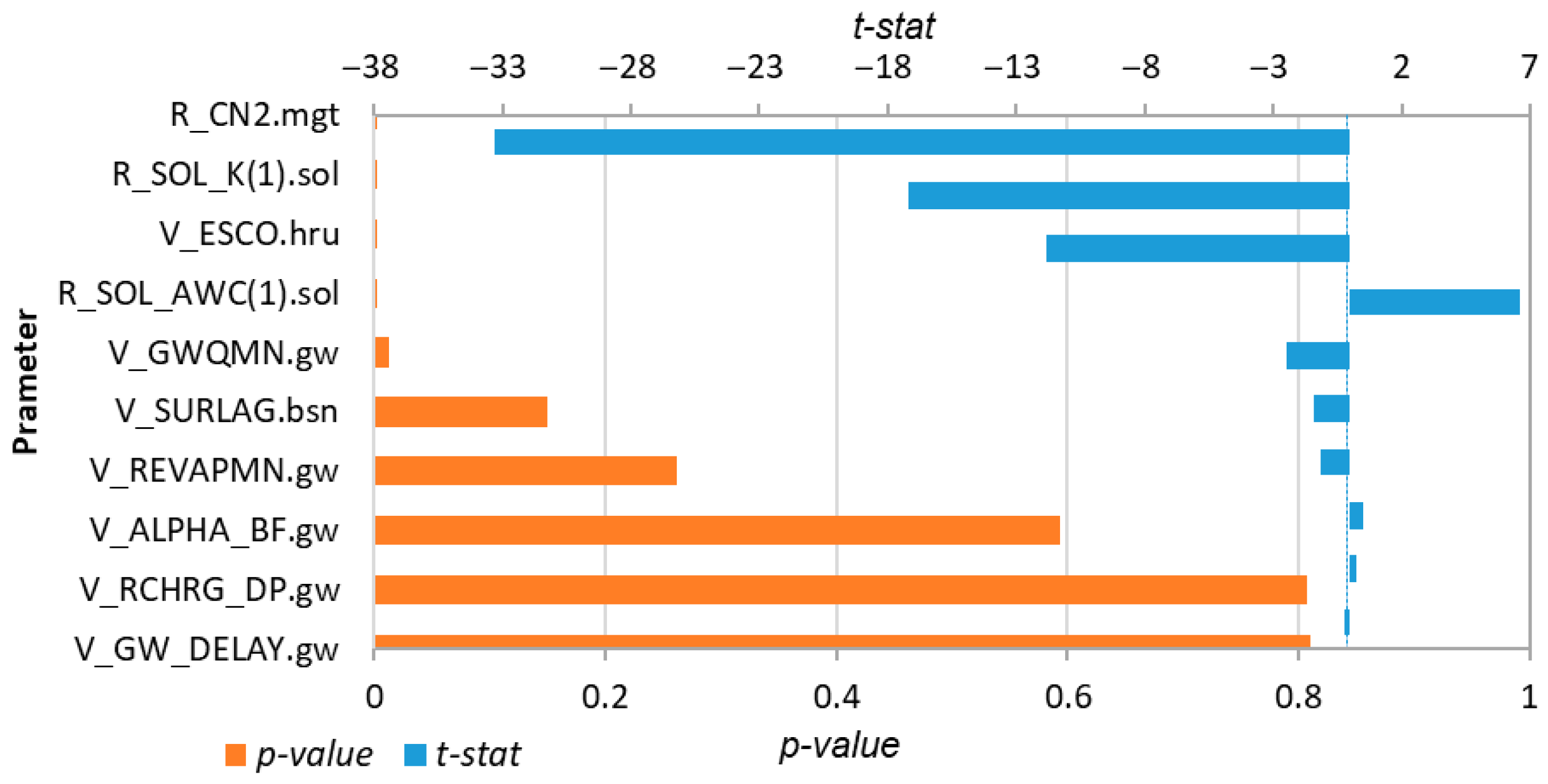

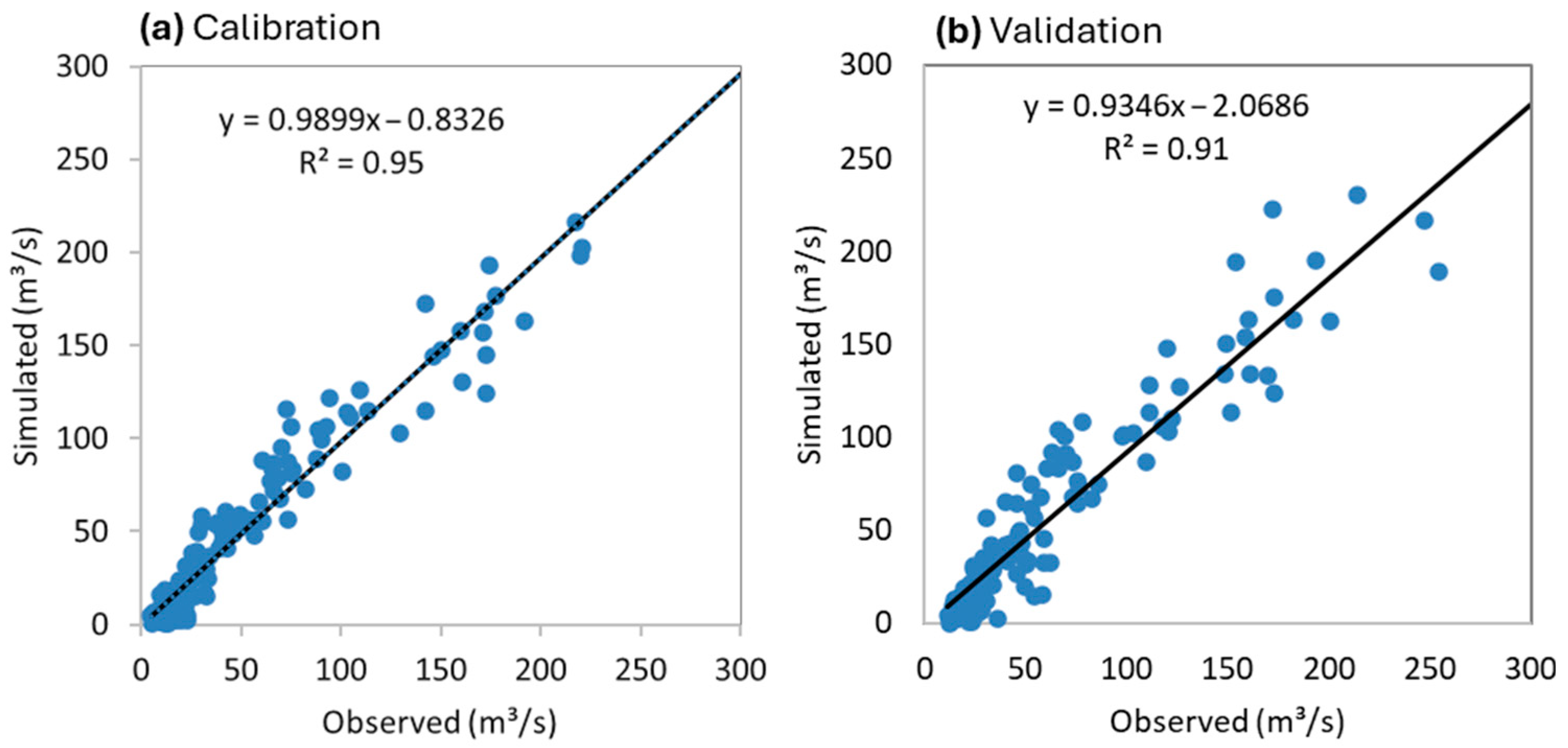
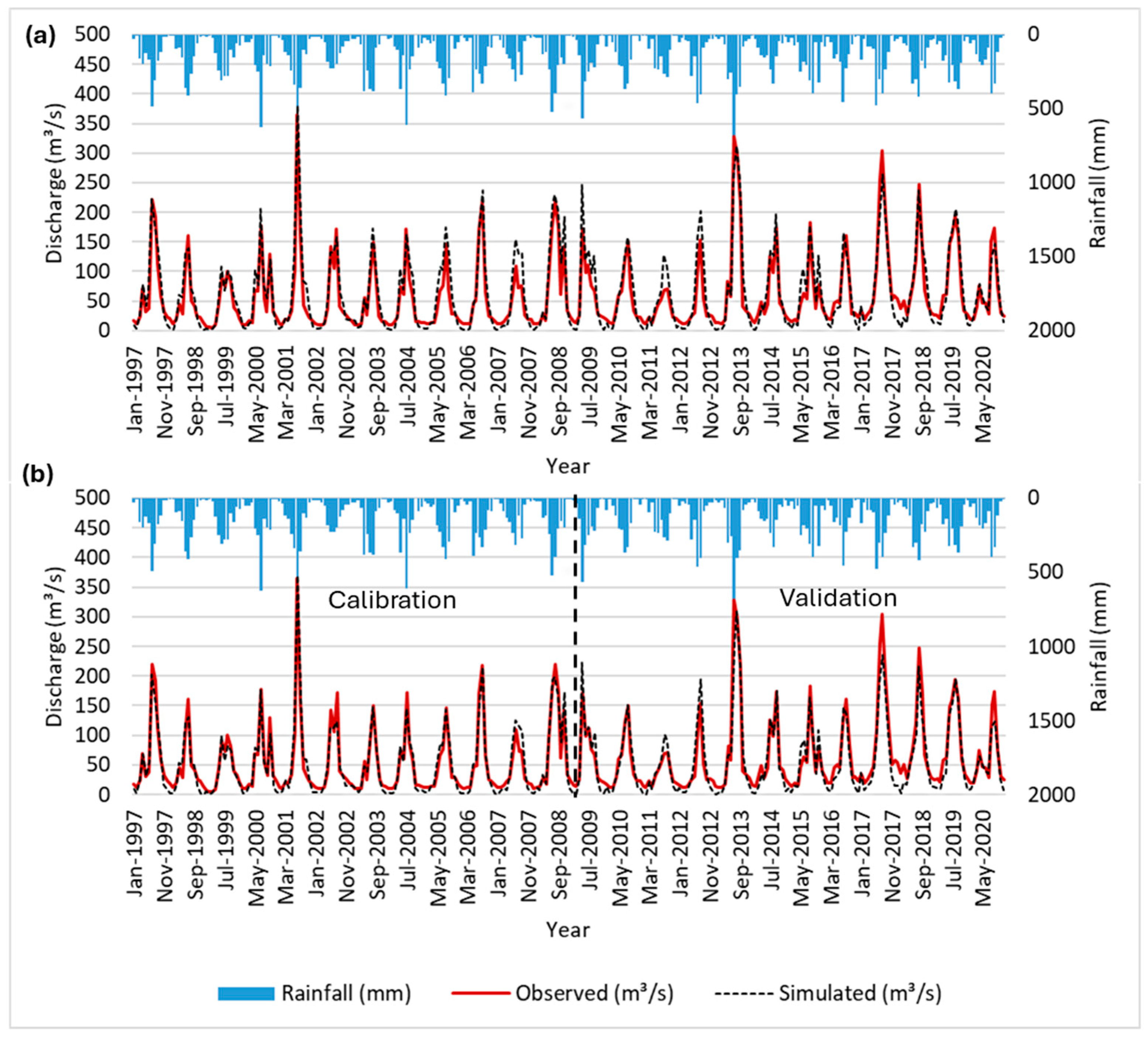
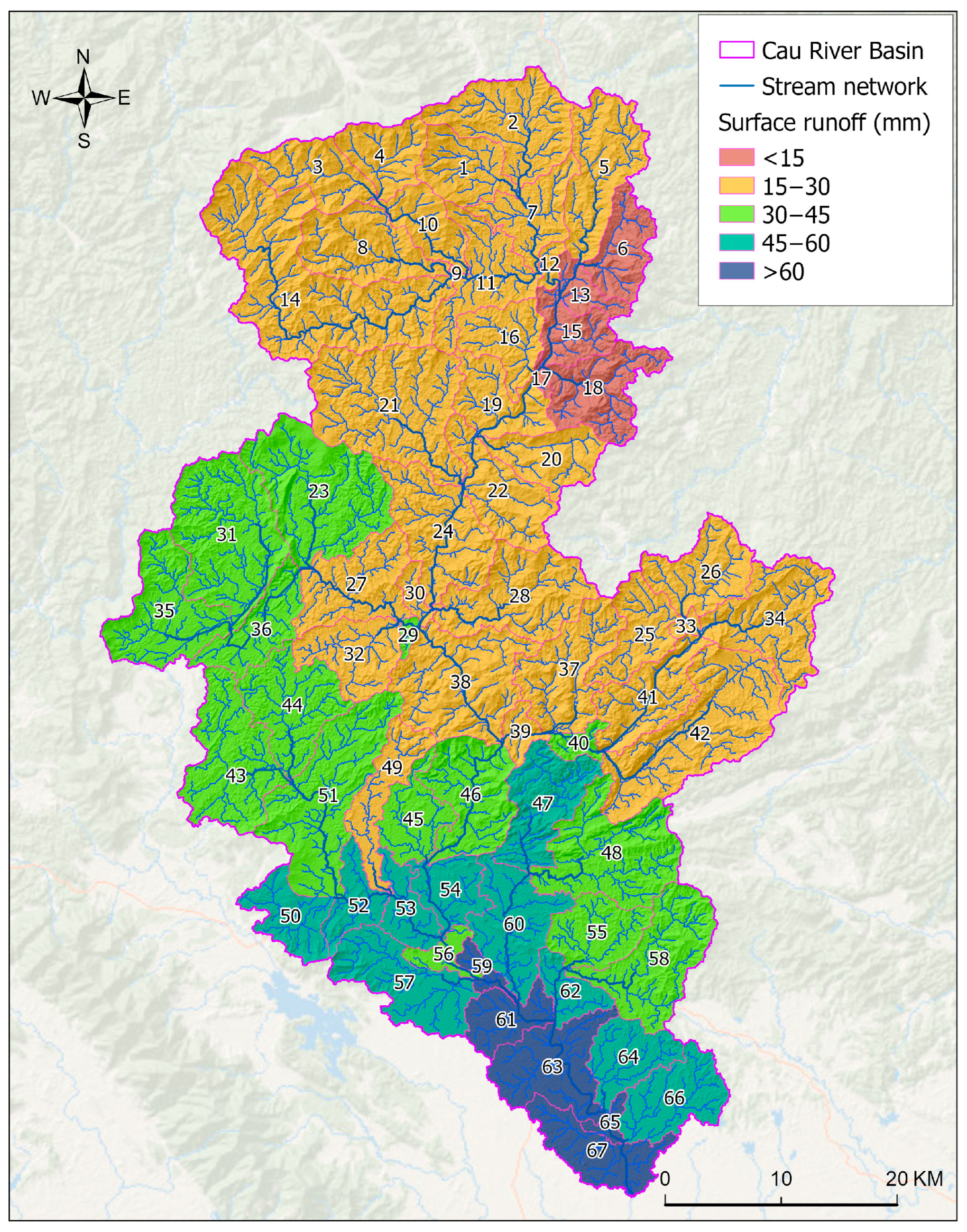

| Parameter | Description | Unit |
|---|---|---|
| CN2.mgt | Curve number | - |
| ALPHA_BF.gw | Baseflow alpha factor | L/days |
| GW_DELAY.gw | Groundwater delay time | days |
| GWQMN.gw | Threshold depth of water in the shallow aquifer for return flow to occur | mm |
| SURLAG.bsn | Surface runoff delay time | days |
| ESCO.hru | Soil evaporation compensation factor | - |
| SOL_K(1).sol | Saturated hydraulic conductivity (topsoil layer) | mm/h |
| SOL_AWC(1).sol | Available water capacity (topsoil layer) | mm/mm |
| REVAPMN.gw | Threshold depth of water in the shallow aquifer for “revap” to occur | mm |
| RCHRG_DP.gw | Deep aquifer percolation fraction | - |
| Parameter | Fitted Value | Minimum | Maximum |
|---|---|---|---|
| R_CN2.mgt | −0.0628 | −0.2 | 0.2 |
| R_SOL_K(1).sol | −0.1010 | −0.2 | 2.0 |
| V_ESCO.hru | 0.9042 | 0.8 | 1.0 |
| R_SOL_AWC(1).sol | 1.2058 | −0.2 | 2.0 |
| Metric | Calibration | Validation |
|---|---|---|
| R2 | 0.95 | 0.91 |
| NSE | 0.95 | 0.90 |
| PBIAS (%) | 2.60 | 9.70 |
| RSR | 0.23 | 0.35 |
Disclaimer/Publisher’s Note: The statements, opinions and data contained in all publications are solely those of the individual author(s) and contributor(s) and not of MDPI and/or the editor(s). MDPI and/or the editor(s) disclaim responsibility for any injury to people or property resulting from any ideas, methods, instructions or products referred to in the content. |
© 2025 by the authors. Licensee MDPI, Basel, Switzerland. This article is an open access article distributed under the terms and conditions of the Creative Commons Attribution (CC BY) license (https://creativecommons.org/licenses/by/4.0/).
Share and Cite
Nguyen, N.A.; Chu, V.T.; Nguyen, L.H.; Ha, A.T.; Nguyen, T.H. Streamflow Simulation in the Cau River Basin, Northeast Vietnam, Using SWAT-Based Hydrological Modelling. Geographies 2025, 5, 41. https://doi.org/10.3390/geographies5030041
Nguyen NA, Chu VT, Nguyen LH, Ha AT, Nguyen TH. Streamflow Simulation in the Cau River Basin, Northeast Vietnam, Using SWAT-Based Hydrological Modelling. Geographies. 2025; 5(3):41. https://doi.org/10.3390/geographies5030041
Chicago/Turabian StyleNguyen, Ngoc Anh, Van Trung Chu, Lan Huong Nguyen, Anh Tuan Ha, and Trung H. Nguyen. 2025. "Streamflow Simulation in the Cau River Basin, Northeast Vietnam, Using SWAT-Based Hydrological Modelling" Geographies 5, no. 3: 41. https://doi.org/10.3390/geographies5030041
APA StyleNguyen, N. A., Chu, V. T., Nguyen, L. H., Ha, A. T., & Nguyen, T. H. (2025). Streamflow Simulation in the Cau River Basin, Northeast Vietnam, Using SWAT-Based Hydrological Modelling. Geographies, 5(3), 41. https://doi.org/10.3390/geographies5030041








